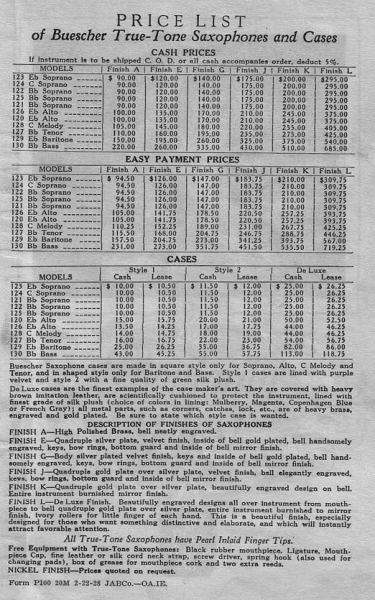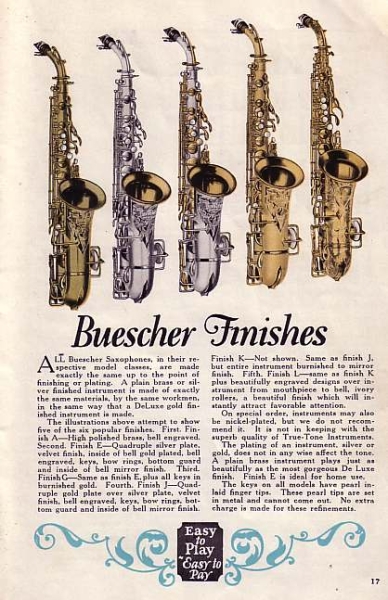|
(Sorry to say that I'm missing the page on the Bb tenor and the C Melody tenor from the above 1923 catalog.)
The Straight Alto and Tipped Bell sopranos are described on a separate page.
The models above essentially reflect the Buescher products from 1916/7 to about 1930. Your mileage may vary.
==========
Some explanation is needed:
* Clicking on the pics open bigger ones :)
* The Model 121 Bb Soprano is the Tipped
Bell instrument. The Model 120 Eb alto is the Straight model. As you
can see, there isn't a difference in prices between the "regular" alto
models or "regular" soprano models.
* Note that the range of instruments is
from Eb sopranino to Bb bass. There is no Eb contrabass in the lineup.
I have heard, but I cannot yet document, that Buescher did something
similar to what Conn did when it came to the Eb contrabass: they
imported a completely different instrument. In Buescher's case, it was the
ROTHOPHONE. For way more information on the Rothophone, go to http://oddwinds.wikispaces.com/Rothphone.
* There was an enamel finish available
*probably* at the same time, with (approximately) the same color
selections and at (approximately) the same price as the Conn New Wonder
instruments. Quoting myself, from the Conn pages:
CHROME FINISH was the [Conn] trade name
for a colored enamel finish. Available colors were red, white, blue,
green, Old Rose ("dark pink") and black. This was available as an
add-on for any style of plating for a mere $15 extra, in March 1922
dollars.
POLY-CHROME FINISH was the [Conn] trade
name for the CHROME finish, but with added "beautiful designs on bell
or body of flowers, vines, etc. in various colors" and cost $25 extra,
in March 1922 dollars.
This finish was brought to my attention by SAXTEK and his beautiful green enamel straight alto.
He has an original factory warranty card and the original receipt, so I
have no reason to doubt that enamel was a factory original finish -- he's also seen another straight alto with a similar finish.
* I've started seeing fairly elaborately
engraved gold-plated horns after around 1916 (and earlier examples
probably exist). I'm generically calling these "Artist Models", to
separate them from the "standard" gold plated horns.
* You may also wish to read about the
"gold wash" found in the bell of many silver-plated Bueschers. There's
a very nice article at cybersax.com.
|







